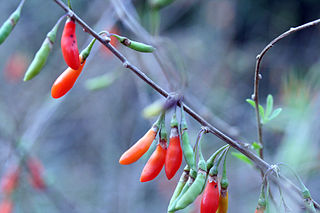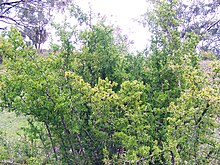
Goji, goji berry, or wolfberry, is the fruit of either Lycium barbarum or Lycium chinense, two closely related species of boxthorn in the nightshade family, Solanaceae. L. barbarum and L. chinense fruits are similar but can be distinguished by differences in taste and sugar content.

Lycium is a genus of flowering plants in the nightshade family, Solanaceae. The genus has a disjunct distribution around the globe, with species occurring on most continents in temperate and subtropical regions. South America has the most species, followed by North America and southern Africa. There are several scattered across Europe and Asia, and one is native to Australia. Common English names for plants of this genus include box-thorn and desert-thorn.

Lycium barbarum is a shrub native to China, with present-day range across Asia and southeast Europe. It is one of two species of boxthorn in the family Solanaceae from which the goji berry or wolfberry is harvested, the other being Lycium chinense.

Lycium chinense is one of two species of boxthorn shrub in the family Solanaceae. Along with Lycium barbarum, it produces the goji berry ("wolfberry"). Two varieties are recognized, L. chinense var. chinense and L. chinense var. potaninii. It is also known as Chinese boxthorn, Chinese matrimony-vine, Chinese teaplant, Chinese wolfberry, wolfberry, and Chinese desert-thorn.
FreeLife International is an American multi-level marketing company established in 1995 by Ray Faltinsky and Kevin Fournier that supplies dietary supplements.
Lycium californicum is a spreading shrub in the nightshade family known by the common names California boxthorn and California desert-thorn.

Lycium andersonii is a species of flowering plant in the nightshade family, Solanaceae. Its common names include water-jacket, redberry desert-thorn, Anderson thornbush, Anderson's desert thorn, Anderson boxthorn, Anderson lycium, Anderson wolfberry, and squawberry.

Lycium ferocissimum, the African boxthorn or boxthorn, is a shrub in the nightshade family (Solanaceae). The species is native to the Western Cape, Eastern Cape, and Free State provinces in South Africa and has become naturalised in Australia and New Zealand. It is listed in Australia's Weed of National Significance list and is a declared noxious weed in the United States.
Coleophora synchrona is a moth of the family Coleophoridae. It is found in Kazakhstan, Turkmenistan and Iran.
Coleophora ningxiana is a moth of the family Coleophoridae which is endemic to China (Ningxia).
Coleophora mosasaurus is a moth of the family Coleophoridae. It is found in the Chinese provinces of Shaanxi and Qinghai and in Turkmenistan.

Lycium ruthenicum, is a flowering plant commonly known as Russian box thorn in the West. is a species of flowering plant in the nightshade family which can be found in Central Asia, southern part of Russia, throughout Northwest China, Northern India and Pakistan. Also commonly known as black fruit wolfberry, goji nero, siyah goji, kaokee, თეთრეკალა, “next to Mary”, is a species of flowering plant in the nightshade family which can be found in Central Asia, southern part of Russia, throughout Northwest China, Northern India and Pakistan.
Scrobipalpa portosanctana is a moth of the family Gelechiidae. It was described by Henry Tibbats Stainton in 1859. It is found in Spain, France, Italy, Croatia, as well as on Sardinia, Corsica, Sicily, Malta and Madeira. It is also present in North Africa and the Near East.
Microlechia chretieni is a moth in the family Gelechiidae. It was described by Turati in 1924. It is found on the Canary Islands, Madeira, Crete and Sardinia, as well as in North Africa, France, Portugal, Spain, Greece and Palestine. It is also present in Saudi Arabia, southern Iran, western Pakistan, Mozambique, Namibia and South Africa.

The Solanaceae, or nightshades, are a family of flowering plants that ranges from annual and perennial herbs to vines, lianas, epiphytes, shrubs, and trees, and includes a number of agricultural crops, medicinal plants, spices, weeds, and ornamentals. Many members of the family contain potent alkaloids, and some are highly toxic, but many—including tomatoes, potatoes, eggplant, bell and chili peppers—are used as food. The family belongs to the order Solanales, in the asterid group and class Magnoliopsida (dicotyledons). The Solanaceae consists of about 98 genera and some 2,700 species, with a great diversity of habitats, morphology and ecology.

Lycium carolinianum, commonly known as Carolina desert-thorn or Christmas berry, is a species of flowering plant in the nightshade family, Solanaceae,

Lycium australe, the Australian boxthorn, is a native Australian plant with large sharp woody spines, small leaves and very small berries. It is closely related to Lycium ferocissimum, which is listed as an invasive weed in Australia, New Zealand and Cyprus.
Hypericum lycium is a species of flowering plant in the family Hypericaceae which is endemic to Turkey.









